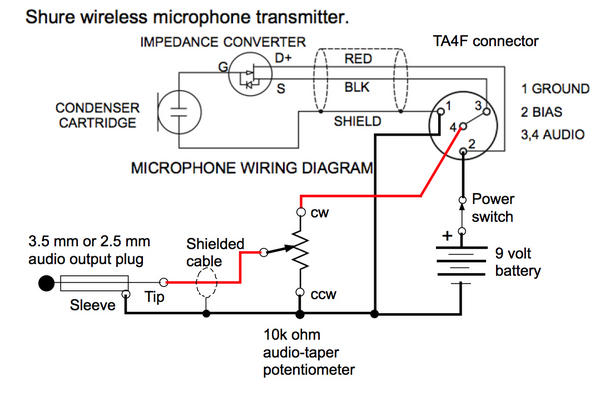I'm doing a little experiment with live-streaming video from a moving car. I'm looking at using this microphone up in the sun visor, and connecting it to this mixer/audio interface [URL=link removed XENYX 302USB which will then be connected to my laptop via usb and narrowcasted to the internet over mobile broadband.
Problem is with the Shure microphone, it's got a T4F connector, and the mixer/audio interface does not accept that connector.
I'm thinking of cutting the T4F connector off of the microphone and soldering in a TRS connector, but the T4F connector has four conductors, and the TRS connector has only three.
I found the https://Shure.custh…"]pin out diagram for the T4F connector[/]="https://Shure.custh…"]pin out diagram for the T4F connector[/] from Shure
That diagram shows the following:
Pin1: shield
Pin2: bias (+5Vdc)
Pin3: audio
Pin4: Bias return
From my research, I've found that the three conductors on TRS connectors are for positive, negative, and drain. What I don't know is how those three would match up to the T4F connector's bias (+5Vdc), audio, and bias return.
How can I make an appropriate connection given the differences between the number of conductors on T4F versus TRS connectors? There is no place to solder the shield wire on a TRS connector, right? Would the shield wire just not be connected on the TRS end? Is there a better way I haven't considered? Thank you.
Comments
I don't think the PG185 to any 3-conductor connector is ever goi
I don't think the PG185 to any 3-conductor connector is ever going to work, sorry. And as far as the mixer goes, when I see the word "Headset" and the mic and headphone jack located together like that, I believe it's looking for [="http://www.fullcompass.com/search.php?txtAll=noise+cancelling+headset&parent=471&sortOrder=lowPrices&itemsPerPage=20&txtLowRange=&txtHighRange="]a headset/mic like a video gamer or sportscaster might wear[/]="http://www.fullcomp…"]a headset/mic like a video gamer or sportscaster might wear[/]. Those kinds of headset mics usually come with a noise-canceling mic, which in a moving car might not be a bad idea. You obviously can't wear headphones while driving, but the noise-canceling mic might be worth trying to adapt. Either worn around your neck or rigged to the visor.
If you want a broadcast quality lavalier mic and aren't on a Ramen noodle budget, there are wired lavalier mics with full-size XLR connectors that come ready to plug into your XLR. You'd have to decide whether you'd be better served by an [[url=http://="http://www.fullcomp…"]omni like the SM93[/]="http://www.fullcomp…"]omni like the SM93[/], [="http://www.fullcompass.com/product/286730.html"]cardioid model[/]="http://www.fullcomp…"]cardioid model[/], or [[url=http://="http://www.fullcomp…"]super-cardioid model[/]="http://www.fullcomp…"]super-cardioid model[/].
Best of luck.
The PG185 will work fine with an unbalanced (or balanced)
The PG185 will work fine with an unbalanced (or balanced) mic input if you meet two conditions:
1. An external +5 to +10 volt bias source is provided (a standard 2U6 9 volt battery is ideal).
2. A DC return for the impedance converter is provided. Some mic inputs are already DC-coupled and will work "as-is", but many are AC-coupled (capacitively coupled) and won't work unless a 10K to 20K resistor is used across the output. A pot is a good solution to provide the DC return path and also to trim gain.
In terms of needing a noise canceling mic or not, you will probably have to try it to determine if the noise pick-up of the PG-185 is objectionable or not.
Schematic attached:




You need a plug-in-power source (5V) for the mic to supply the l
You need a plug-in-power source (5V) for the mic to supply the line marked "bias" on the T4F connector. The Xenyx 302USB has a 1/8" TRS headset mic jack, and it's possible that it can supply plug-in power, but there's no information about it in the user guide. I would try connecting the shield and bias return line to the jack sleeve, the audio to the jack tip and the bias line to jack ring. This is likely to be the correct wiring, but it's by no means certain.
If that doesn't work, external battery-operated plugin-power sources are fairly easily available, or you might want to go for a phantom power (48V) to plug-in-power converter. We can advise further if needed.